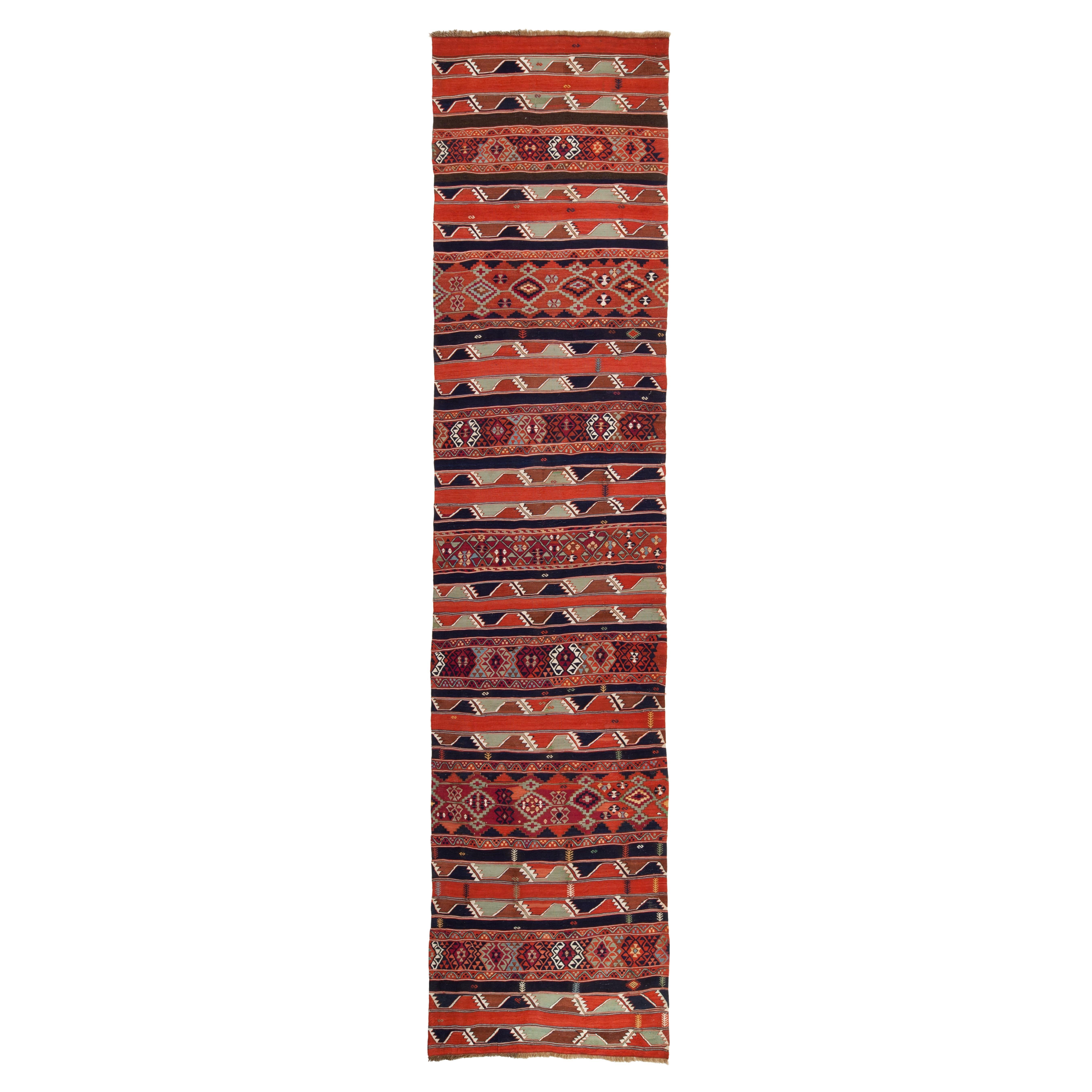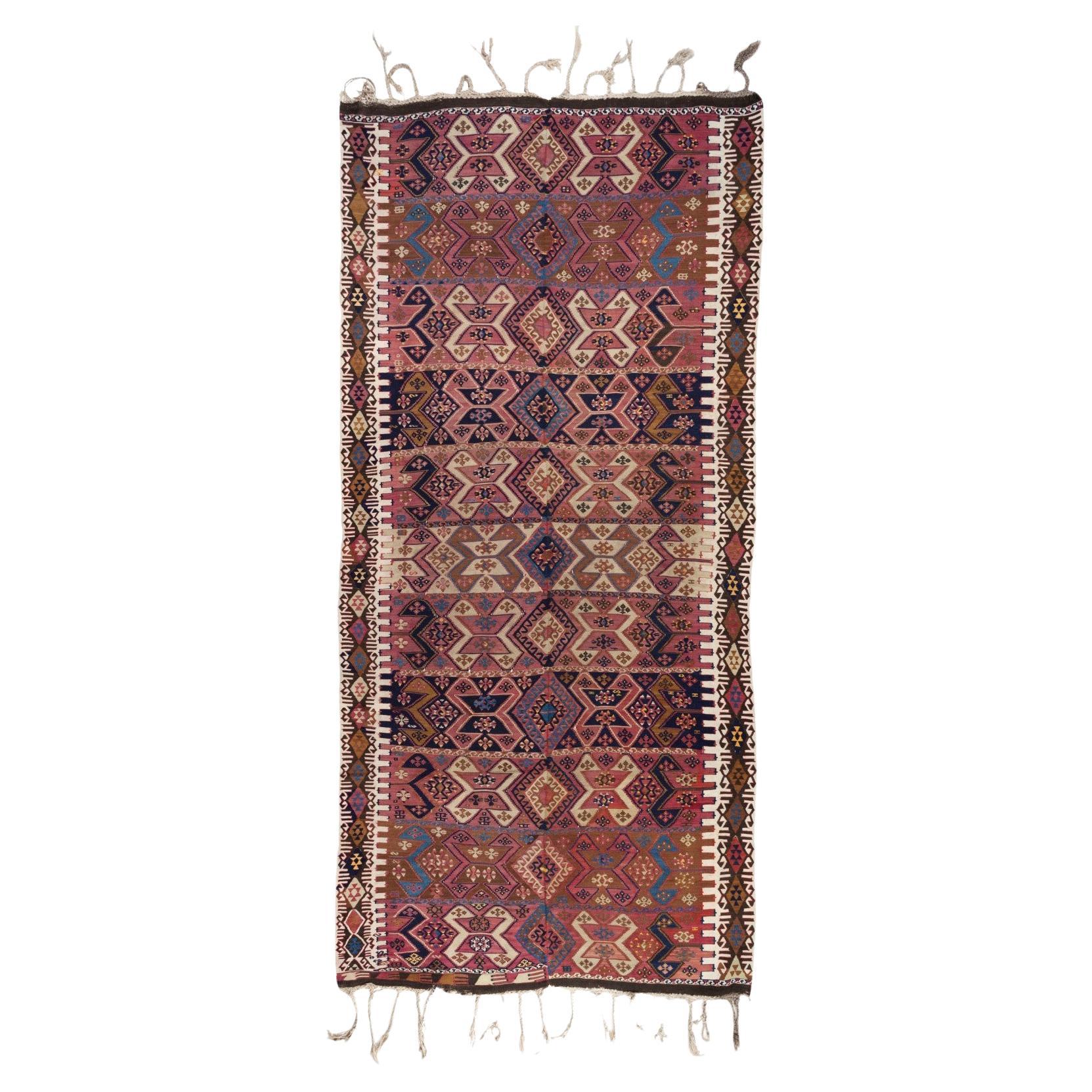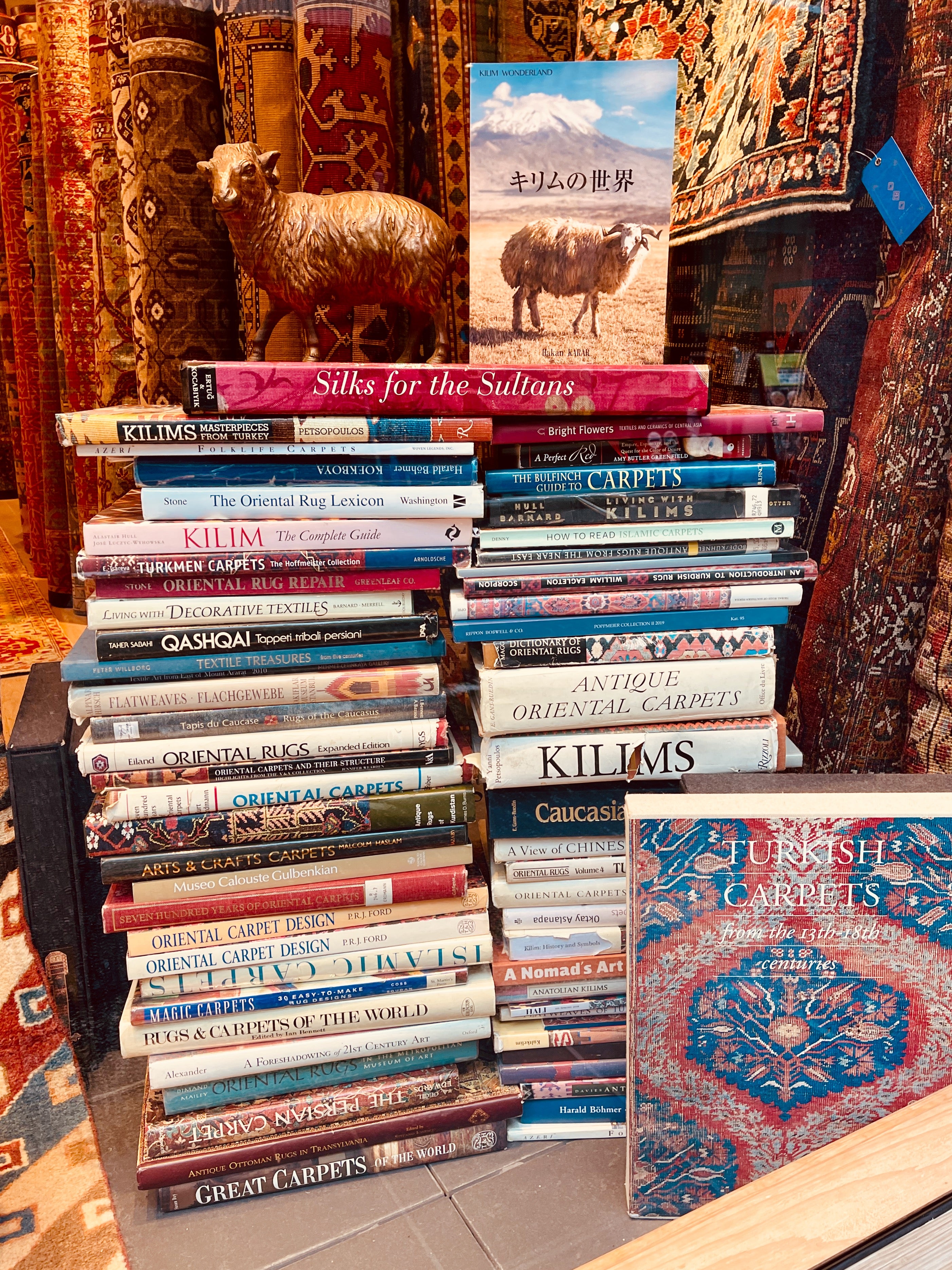Items Similar to Antique Malatya Runner Kilim Rug Anatolia Turkish Carpet
Want more images or videos?
Request additional images or videos from the seller
1 of 8
Antique Malatya Runner Kilim Rug Anatolia Turkish Carpet
About the Item
This is a South Eastern Anatolian Antique runner Kilim from the Malatya region with a rare and beautiful color composition.
Malatya is Turkey's main kilim production area, and there are many variations. This is one of them, a runner-type kilim. The thread is thin and the weave is very fine and dense. Some metallic threads are used in this antique kilim, which is rarely seen in Anatolian kilims. There are many layers of patterns with different expressions. The alternating medallions have star and flower motifs, making them look like lovely textiles with a design.
Looking closer, the wool is thin and strong, well-twisted and tightly woven.
The bluish-red color is very wonderful, and the combination of deeper colors such as navy blue, green, black, and charcoal gray adds to the unique depth. The contrast between yellow and white adds vibrancy, while the dark beige calms down the entire look with just a small amount. These colors are not necessarily arranged according to a fixed rule but are arranged according to the weaver's heart, and the randomness gives the kilim a three-dimensional feel and movement.
Malatya is a town built on one main street that continues for several miles. It is situated in the Tohmasuyu River basin which is encircled by the high peaks of the eastern Taurus Mountains. This is a fertile agricultural region, particularly for apricots, and has been a prolific weaving area for many years. The modern town was established in 1838; old Malatya, which is close by, was once an important city in Armenia Minor. In Roman times it was important as a garrison town on the eastern frontier, and the settlement came under Ottoman rule in the early fifteenth century. Considering the number of kilims woven in this region there is a surprising lack of diversity in design, especially in the larger kilims; this is possibly a direct result of the Kurdish tribal tradition of weaving only one type of design. Small prayer rugs are more varied and often have great character and individuality. The quality of the kilims now woven in the region is deteriorating, and production for commercial purposes is slowly spreading into the villages. Large kilims generally feature three or four central medallions, while the smaller variety is usually decorated with one in the center. Some of these kilims have been referred to as 'Rashwan' weavings. The Rashwan was a Kurdish tribe that settled in parts of central and eastern Anatolia. These kilims are not easy to weave, for the designs are complicated and the filler motifs plentiful; indeed, their value has probably been underestimated by the market. Another variety of medallion kilim is also found in a smaller size and features a hexagonally shaped medallion with arms or hooks extending from the sides. This is used as a central motif arranged in a vertical line for smaller kilims, and for larger sizes, it is repeated in rows down the field. Such a motif is also found in Aksaray and Aleppo kilims, which have a lighter color palette. Banded kilims are borderless, and patterned with both narrow and wide alternating stripes. These are decorated with small motifs, often in supplementary weft-wrapping technique, and separated either by smaller patterned bands or by a plain color. Large sizes are made in two halves. As in other Kurdish weavings, a dark color palette of red, blue, brown, and some green is used that contrasts with undyed wool or bright white cotton. The wool is of good quality and lustrous, and sometimes very finely spun. Weaving techniques vary a great deal; some kilims incorporate both plain-weave and supplementary weft wrapping, although slit-weave is predominantly used. The fringes of Malatya kilims are sometimes plaited. Many different sizes are found - large kilims, generally woven in two halves, small kilims, yastiks (cushions), and çuval (sacks).
- Dimensions:Width: 34.26 in (87 cm)Length: 117.33 in (298 cm)
- Style:Kilim (In the Style Of)
- Materials and Techniques:
- Place of Origin:
- Period:
- Date of Manufacture:circa 1920s
- Condition:Wear consistent with age and use. Minor fading.
- Seller Location:Tokyo, JP
- Reference Number:1stDibs: LU8206238253512
ARARAT RUGS
We know and believe that the geography we come from, our past, and our lifestyle are the most important bond between us to carry the oriental carpet art and culture to the next generations along with our core values in our ongoing growth journey.
We are aware that the way to achieve this goal and carry this priceless art and culture to the future depends on a lot of work with all our people every day while adhering to our core values.
For us, art is meaningful in the sense that it brings together various cultures around the world. It is an honor for us that oriental carpet art and culture have been instrumental in this for centuries and that we are a part of this business.
We are tirelessly keeping an eye on auction house information around the world about carpets. New York's Metropolitan, London's Victoria & Albert Museums, and other famous art museums, as well as small specialized museums that house private collections, and books about oriental carpets to collect information on outstanding carpet designs and patterns from around the world. It's our Self-improving and Self-developing culture.
As Turkish Culture of Hospitality, the Kurdish Culture of Generosity, and as Japanese Culture of Business Punctuality; are the most important values that this multicultural background has taught and bequeathed to us. It is essential and valuable for us that you feel this feeling not only by looking at our oriental carpets but from the moment you contact us.
About the Seller
5.0
Gold Seller
These expertly vetted sellers are highly rated and consistently exceed customer expectations.
Established in 1970
1stDibs seller since 2023
12 sales on 1stDibs
Typical response time: <1 hour
- ShippingRetrieving quote...Ships From: Tokyo, Japan
- Return PolicyA return for this item may be initiated within 7 days of delivery.
More From This SellerView All
- Antique Malatya Runner Kilim Rug Anatolia Turkish CarpetLocated in Tokyo, JPThis is a South Eastern Anatolian Antique runner Kilim from the Malatya region with a rare and beautiful color composition. Malatya is Turkey's main kilim production area, and the...Category
Early 20th Century Turkish Kilim Turkish Rugs
MaterialsWool, Natural Fiber
- Antique Malatya Runner Kilim Rug Anatolia Turkish CarpetLocated in Tokyo, JPThis is a South Eastern Anatolian Antique runner Kilim from the Malatya region with a rare and beautiful color composition. Malatya is Turkey's main kilim production area, and there are many variations. This is one of them, a runner-type kilim. The thread is thin and the weave is very fine and dense. Some metallic threads are used in this antique kilim, which is rarely seen in Anatolian kilims. Red, navy blue, and gray are the colors that determine the impression of this kilim. Other colors such as brown, yellow, and light blue are also used in the patterns. The wavy horizontal striped pattern, plain pattern, and lined motif pattern are woven together to create a kilim that looks like an obi. The pattern of the motif and the pattern of the wave are about the same amounts, giving a lively impression without getting busy. The deep shades of colors and patterns that are familiar to each other are unique to antiques. However, it still retains good coloring which makes it hard to believe that it is antique. The runner type is a good type to make this kilim unique. Also, for those who want to create a different kind of home, the use of runners is very effective. Malatya is a town built on one main street that continues for several miles. It is situated in the Tohmasuyu River basin which is encircled by the high peaks of the eastern Taurus Mountains. This is a fertile agricultural region, particularly for apricots, and has been a prolific weaving area for many years. The modern town was established in 1838; old Malatya, which is close by, was once an important city in Armenia Minor. In Roman times it was important as a garrison town on the eastern frontier, and the settlement came under Ottoman rule in the early fifteenth century. Considering the number of kilims woven in this region there is a surprising lack of diversity in design, especially in the larger kilims; this is possibly a direct result of the Kurdish tribal tradition of weaving only one type of design. Small prayer rugs...Category
Early 20th Century Turkish Kilim Turkish Rugs
MaterialsWool, Natural Fiber
- Antique Malatya Kilim Rug Anatolia Turkish CarpetLocated in Tokyo, JPThis is a South Eastern Anatolian Antique Kilim from the Malatya region with a rare and beautiful color composition. It is a large size and has two pieces joined from the center. Al...Category
Early 20th Century Turkish Kilim Turkish Rugs
MaterialsWool, Natural Fiber
- Antique Malatya Kilim South Anatolia Rug Turkish CarpetLocated in Tokyo, JPThis is a Southern Anatolian Antique Kilim from the Malatya region with a rare and beautiful color composition. This kilim is listed in the book; Kilims Flat-woven Tapestry Rugs, Yanni Petsopoulos, 1979 Rizzoli New York, plate nr. 241. The brocaded bands cross the entire width of the field forming panels contained within very narrow borders. Their decoration consists of a series of alternating large and small concentric hooked lozenges. Malatya is a town built on one main street that continues for several miles. It is situated in the Tohmasuyu River basin which is encircled by the high peaks of the eastern Taurus Mountains. This is a fertile agricultural region, particularly for apricots, and has been a prolific weaving area for many years. The modern town was established in 1838; old Malatya, which is close by, was once an important city in Armenia Minor. In Roman times it was important as a garrison town on the eastern frontier, and the settlement came under Ottoman rule in the early fifteenth century. Considering the number of kilims woven in this region there is a surprising lack of diversity in design, especially in the larger kilims; this is possibly a direct result of the Kurdish tribal tradition of weaving only one type of design. Small prayer rugs...Category
Early 20th Century Turkish Kilim Turkish Rugs
MaterialsWool, Natural Fiber
- Antique Rashwan Malatya Kilim Anatolia Rug Turkish CarpetLocated in Tokyo, JPThis is a Southern Anatolian Antique Rashwan Kilim from the Malatya region with a rare and beautiful color composition. It is a large, 4 meters long Kilim with two halves attached...Category
Early 20th Century Turkish Kilim Turkish Rugs
MaterialsWool, Natural Fiber, Organic Material
- Antique Malatya Kilim South Anatolia Rug Turkish CarpetLocated in Tokyo, JPThis is a Southern Anatolian Antique Kilim from the Malatya region with a rare and beautiful color composition. It was originally a kilim with two halves, but this is one half. Encountering such a piece is precious. Half of them are somewhere else in the world, or they are the survivors of Kilims who might otherwise have disappeared from this world due to special damage that is difficult to repair. Kilim is such an organic existence. That's why you can enjoy the encounter with your piece a once-in-a-lifetime chance. As you can see at a glance, each color is a very beautiful kilim. You can enjoy the goodness of ablush from the deep red to the bright color close to orange. Dark blue, orange, khaki, and white complement each other, making each color more vivid. What makes it unique is the beauty of khaki. Also, the dark brown on the border that tightens all the colors is a modest presence, but I think it's very beautiful to change the expression. Malatya is a town built on one main street that continues for several miles. It is situated in the Tohmasuyu River basin which is encircled by the high peaks of the eastern Taurus Mountains. This is a fertile agricultural region, particularly for apricots, and has been a prolific weaving area for many years. The modern town was established in 1838; old Malatya, which is close by, was once an important city in Armenia Minor. In Roman times it was important as a garrison town on the eastern frontier, and the settlement came under Ottoman rule in the early fifteenth century. Considering the number of kilims woven in this region there is a surprising lack of diversity in design, especially in the larger kilims; this is possibly a direct result of the Kurdish tribal tradition of weaving only one type of design. Small prayer rugs...Category
Early 20th Century Turkish Kilim Turkish Rugs
MaterialsWool, Natural Fiber
You May Also Like
- Antique Dizmeck Kilim Turkey Wool RugLocated in Barcelona, BarcelonaRug antique Dizmeck Kilim from Turkey Composition with vintage wool fabrics from East Turkey Measures: 199 x 200. 20382 199 x 200 C3.Category
1990s Turkish Kilim Rugs
MaterialsWool
- Kagizman Kilim Runner RugLocated in New York, NYKagizman Kilim runner rug. A wonderful old tribal flat-weave from Northeastern Turkey, woven in wide runner rug format that is common among the nomadi...Category
Early 20th Century Turkish Kilim Turkish Rugs
MaterialsWool
- Vintage Turkish Sharkoy Kilim RugLocated in Torquay, GBVintage Turkish Sharkoy Kilim rug. Large sized 325cm x 225cm Monumental large area rug measuring over 3metres wide. Beautiful Ikat pattern with vibrant colours. Tightly woven cott...Category
Mid-20th Century Turkish Kilim Turkish Rugs
MaterialsCotton
- Antique Central Anatolian Kilim RugLocated in New York, NYAntique Central Anatolian Kilim rug. A great example of Anatolian Kilim rug weaving from the 19th century when tribal women wove such pieces as...Category
Antique Late 19th Century Turkish Kilim Turkish Rugs
MaterialsWool
- Antique Oushak Runner, Turkish and Oriental Rug, Handmade Beige and Orange RugLocated in Port Washington, NYWest Anatolia is one of the largest weaving regions in Turkey. Since the 15th century, Turkish rugs have always been on top of the list for having fine oriental rugs. Oushak rugs su...Category
Early 20th Century Turkish Oushak Turkish Rugs
MaterialsWool
- Antique Oushak Carpet, Handmade Turkish Oriental Rug, Beige, Taupe, CharcoalLocated in Port Washington, NYWest Anatolia is one of the largest weaving regions in Turkey. Since the 15th century, Turkish rugs have always been on top of the list for having fine oriental rugs. Oushak rugs su...Category
Mid-20th Century Turkish Oushak Turkish Rugs
MaterialsWool






